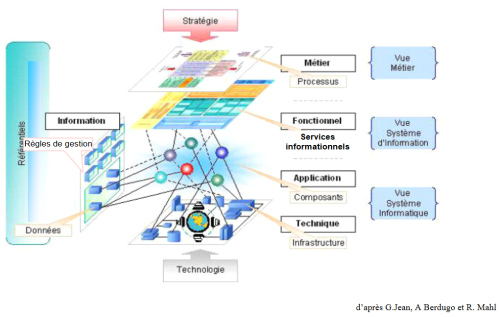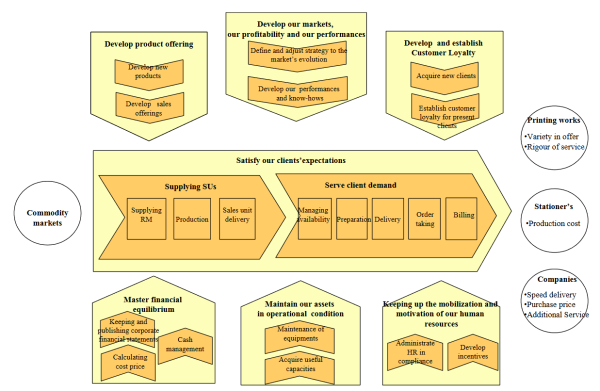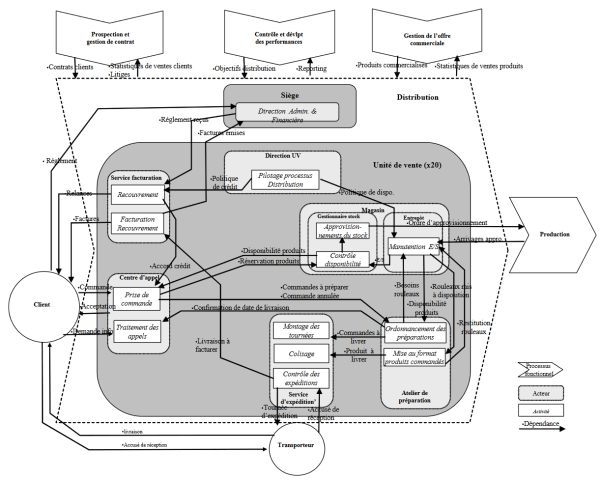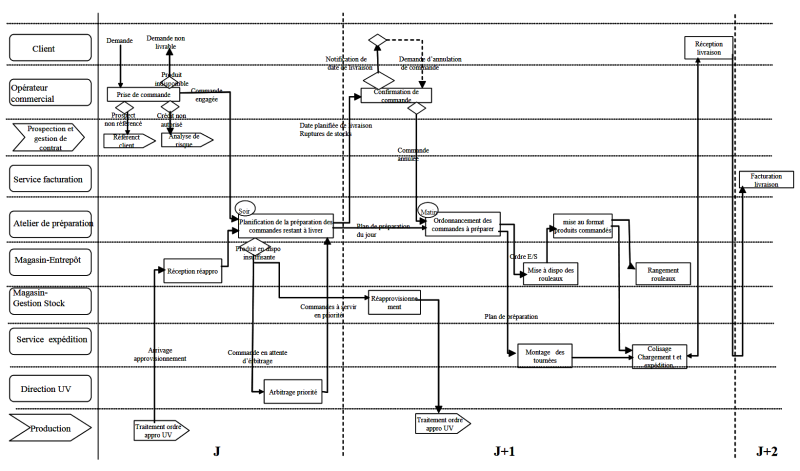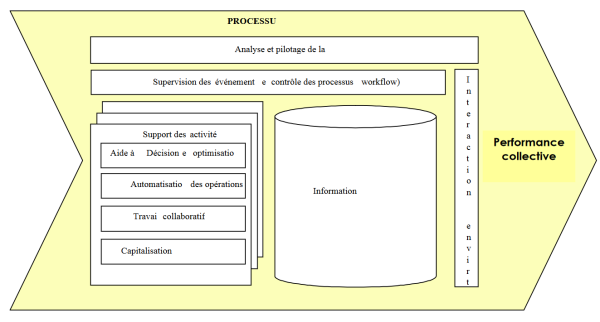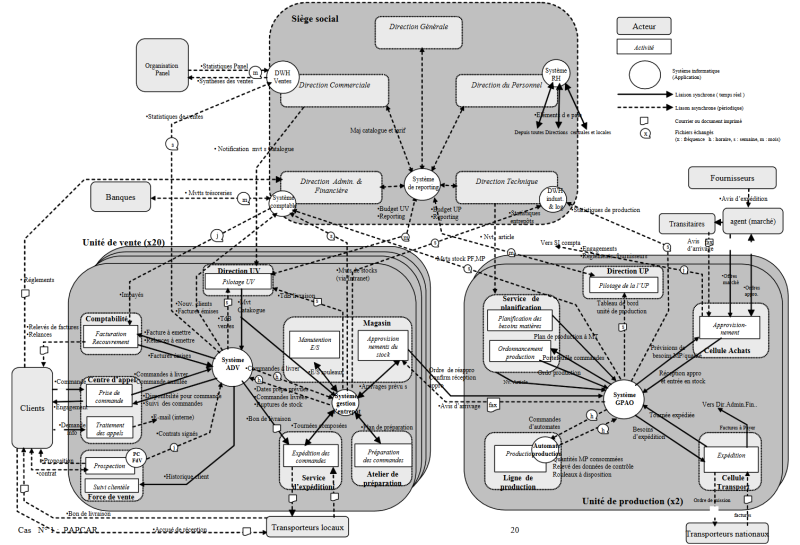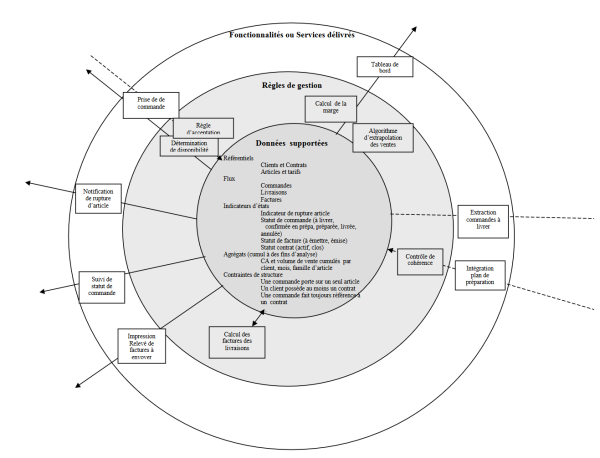Cas PAPCAR (English)
Which places for information systems within organizations and which contributions to the performance of the organized processes ?
THE PAPCAR COMPANY
PAPCAR produces paper for the purpose of writing, printing and graphic arts, and realizes a turnover close to 150 million Euros. Despite 15% of its turnover realized abroad within different interests, its sphere of activity is, today, essentially in France.
In this sector of products holding a standardized appearance, PAPCAR still holds a position of historic leader nationally speaking. The company faces however two main competitors in perpetual progression adopting more aggressive sales approaches, built on the fame of its brand for one of them, on good prices for the other:
- A distributor representing in France the main British 🇬🇧 and American brands 🇺🇸,
- A subsidiary of a Deutsch 🇳🇱 company recently implemented in France, that distributes basic products within a market turned attractive by the growing consumption of companies.
THE PAPCAR OFFER
PAPCAR presents its proposition with two essential characteristics: « Variety in choice» and « Speed delivery ».
Variety in choice
PAPCAR offers with no restriction a variety in size cuts, some 5000 sorts of paper, resulting from combining various qualities of pulp, and variations of grammage and colours decided by production. 10 new sorts per year are added to the catalogue, little is taken out.
Within facts, only about a hundred of these articles stand the flow of regular demands and can be qualified of ‘standards’, the rest of the catalogue being for a more specific and occasional demand, generally liable to trends (particular warps) or even seasonal variations (colours).
The rolls of paper are produced from pulps supplied by international suppliers, and which, according to their origins, offer a strong diversity in fibres.
The fabrication proceeds in three steps:
- transformation, thanks to chemical additives, of the suited pulp as to obtain the required quality,
- addition of the necessary pigments for the required shade,
- drying and rolling as to obtain an even-shaped roll (that would allow obtaining by cutting to shape some 400 reams of 500 A4 leaves).
Speed delivery
PAPCAR is the fruit of the merger of two companies complementary from a geographic point of view. This merger has preserved their major asset: proximity and capacity to deliver every client within a very short delay, from 48 hours to a week depending on availability.
Proximity leans on more than 20 sales units, in charge of distribution, from order-taking to delivery.
CLIENTELE
PAPCAR offers its services to 3 types of clientele: printing houses, stationer’s and companies.
These few figures show the relative importance of each segment:
- Number of clients (% of delivery places):
- 35 % of printing houses, 40 % of retailing stationers, 25% of companies.
- Turnover realized (% of overall turnover):
- 45% of printing houses, 25% stationers, 30% companies. Contribution to mark-up:
- 90% printing houses, -5 % stationers, 15 % companies.
- National market share:
- printing houses 50 %, stationer’s 30 %, companies 10 %.
Despite their different expectations, PAPCAR has put in place an organisation and some homogeneous techniques as to answer the needs of these populations:
- By the wide range of its catalogue, PAPCAR is a key supplier for printing houses. These latter work under orders for companies and individuals that are looking for a capable project manager, beyond printing, to assist them with the design and editing of their works (PR brochures, catalogue, business cards, advertising leaflets, …) and to give them advice regarding the choice of the most appropriate paper with the effects and budgets sought.
- The printing houses’ expectations depend on it: variety in offer, quality, shades and prices, and even more, the assurance of a reliable and quick supply. However, the advantage of the PAPCAR catalogue is now foiled by the advantage in price of competition regarding the most basic products, at the risk of being only used for marginal needs, where competition has no solid offer.
- Stationer’s, ordinary retailers, are basically vigilant on the profit margins they can take. Paper only constitutes a loss leader (reason for entering the shop), that allows the stationer once done with the demand, to attract the customer’s attention on a book or any other product having a higher mark-up. That is why do they only make, most of the time, with just a selection of the most basic products (no more than 20) that they stock in small quantities and almost re-supply one by one. Besides theses basic products, they have PAPCAR’s general catalogue to satisfy if needed, any particular demand.
- Low prices and speed in re-supplying determine the choice in suppliers. If PAPCAR has managed until now with its clients, the arrival of more competitive competitors does force it to erode its margins to such a point that this segment is today in the red.
- A more strained competition turns the company market to be difficult but attractive because of the increasing volume in consumption of printers and photocopiers. The standardization of products gives more than their due to the highest bidder, even if it means changing suppliers for every order. As to compensate its price handicap, PAPCAR puts forward its service capacities:
- Speed delivery service in less than 8 hours, against 48 hours at the best for its competitors, made possible by the proximity of its regional layouts;
- Capacity of setting up and coordinating operations with printing houses by supporting them in their mass reprography operations, for in-house communication or promotion.
As a synthesis, we will highlight the importance in this market of the balance between quality of service and cost control on markets where the development of customer loyalty is the only carrier of profitability on the long-term.
PAPCAR has organized itself as to better answer, in its mind, this search for balance.
THE PRESENT ORGANISATION
PAPCAR’s activity is shared out into several units:
- The Company’s registered office, located in Paris, and where are the Head Office and the main functional Departments such as :
- the Sales department, in charge of defining the price policy of products, to allocate sales objectives to sales units and to coordinate the negotiation of contracts with national major accounts;
- the Financial and administrative department that centralizes cost and tax accounting, centralized cash management, as well as the consideration of investment dossiers;
- the Works department, in charge of developing new products as well as the industrial organisation of production and logistics (investment needs, techniques, equipment maintenance policy) ;
- the Human resources department, which centralizes payments, staff management, in-house communication, etc.
- 20 Sales and distribution units, laid out locally as to serve 3 to 5 departments, are in charge of canvassing and surveying, reception, delivery and billing orders. They report to Sales management that sets margin and expansion objectives as well as goals for the development of customer loyalty. In each units are a Local management and 6 activity poles:
- a sales force, composed of 3 to 5 sales engineers, in charge of canvassing clients, negotiating contractual sales conditions (personalized discounts), dealing with commercial disputes and coordinating special operations on behalf of companies;
- a centre for receiving orders, capable of dealing with some hundred daily phone calls, for order-taking but also for inquiries (10% of calls), request for information about the follow-up or confirmation of delivery dates (20%), or for complaints (10%) ; after having checked the identity of the caller, they start the order-taking process, or conduct requests by transmitting them most of the time to the services concerned (representatives, accounting, preparation or expedition workshops, Unit Manager).
- The procedure seems today rudimentary: Only the orders from listed clients and that are not on the black list, are taken into account. Orders are accepted under the only condition that the presence in stock of the products asked is checked. In case of outage or stock level appearing to be low, the operator enquires by phone to the warehouse or preparation workshop as to be sure of the true availability, and if not, of the date of the forthcoming arrival of the product in question. Even though taken into account, the delivery date wished by the client cannot be guaranteed right away. The delivery date will be planned by the preparation workshop, depending on its production planning.
- a warehouse able to contain 2000 rolls, in charge of managing supplying for the plants, as well as the handling (5 fork-lift truck operators) of the rolls from the warehouse to the preparation workshop (300 daily movements regarding going and leaving rolls); everyday, depending on the quantities left of each product, on the average delivery deadline (4 weeks), on the consumption statistics, and on the room left in the warehouse, the head of the warehouse decides of the supply needs with the production units.
- a preparation workshop takes care of cutting in size the ordered products and handing themin to the delivery service; it operates according to an optimized planning of works, aiming at minimizing off cuts and manipulations of the rolls between the workshop and the warehouse, according to the visibility of the order book, of the wished delivery dates indeed even urgent (companies) and of the capacity of postponing for a short while partial preparations.
- a delivery service in charge of grouping orders and setting up delivery rounds entrusted to lorry drivers under contract; the delivery slips, once returned countersigned by the clients, are given to the invoicing department so it can proceed to billing.
- an invoicing department in charge of establishing invoices and sending reminder letters in case of delay in payment. Payments are sent directly to the financial department in charge of relations with banks. All disputes or delays are notified to the representative in charge of the concerned client account.
- 2 Production units, one located not far from the Havre harbour, and the other near Bordeaux, are in charge of supplying the sales units with rolls, ready to be cut into shape. They are attached to the Works department and are mainly responsible for cost objectives, service delivered products in response to the demands coming from the sales units.
- Despite identical fabrication process, these units share out among them the product range: the first one, equipped with a recent and highly automated industrial tool, covers the upper part of the range (short runs), the second one, equipped with older but robust tools is in charge of the standard paper range (long run). Rolls produced are not kept in stock. They are delivered straight away to the sales units that have ordered them.
The activity of one production unit is shared out into 5 departments:
- The planning department, in charge of short term programming (4 coming weeks) for the necessary production to cover the demands of the sales units, taking into account maintenance
- operations. It estimates elsewhere the supply needs in pulp on the medium term (12 months) as to give the supply service the leeway for optimizing its orders according to price trends. Given the work schedule, the delivery average delay for a demand from a sales unit is of 4 weeks;
- The production workshop, more or less automated depending on the factory, not comprising loading and adjustments when changing products, under control of technicians;
- the transport service, in charge of coordinating the necessary transportations to the supplying of sales units;
- the supply service, in charge of administrating pulp supplies necessary to the needs of the unit; it now puts in orders to a wholesaler dealer, capable of intervening on market places with the main traders or international producers and capable of coordinating the deliveries all the way to the door of the factory’s warehouse (with a delay of 2 to 4 months depending on the place of origin). Supplementary stocking capacities can, if needed, be used in the warehouses situated nearby the factory as to cover possible anticipated supplies (according to availabilities and the evolution of price indicated by the agent) ;
- a maintenance and method department, in charge, on the one hand, of supervising the production setting of new products but also to supervise and coordinate the up-keep and fixing of the machines in case of dysfunction, in collaboration with the original suppliers or specialized providers.
THE EXISTING INFORMATION SYSTEM
As for most firms born before the generalized usage of information technologies, the already existing information system does not come from an overall conception that would have aimed all in all at the optimal support of operational activities and the pertinent support of management activities and that would have anticipated the organisational transformations expected in the medium and longer term. On the contrary, the information system in place grew by the adjunction in time of computer applications conceived and put in place in a purely pragmatic approach to search for efficiency. The first cartography presented in appendix 6 situates the different computer applications put in place within PAPCAR units and that support together the information system of PAPCAR.
We will first examine the content and usefulness of this system, we will identify the limits and wants within the present organisational context, and then we shall develop the different possible evolution scenarios, as to be able, in a first place, to overcome the daily problems met, as to anticipate in a second place a more strategic focus on medium and long term.
As to describe and manipulate the different components of the Information System (IS), we shall follow the following canvas put forward by city planning practitioners and that tries and answer the following questions:
- To what jobs and what stakes does the IS contribute?
- By what informational services does the IS contribute to the setting up of an organization capable of answering these stakes?
- What definitions and management rules are placed out and conveyed through these services?
- By what means are elaborations regarding technologies as well as in what overall applicative architecture are these services actually delivered?
- What is the infrastructure that allows services to ensure the performing, availability and required security levels?
Business View
The representation of the business describes on the one hand the goals targeted by the action of organizing, and on the other hand, the operating process actually set up for the organisation.
The first representation, cartography of processes, sums up the objectives of the organisation, in line with the comprehension of markets and activities that compose the business and the raison d’être of the company: what the company looks to mastering as to exist.*
At a first level (in light colour on the diagram) the company puts up its organisation goals, by setting forth the more general -or strategic- process in view of the expectations of the market and to which it must elaborate an answer, in the framework of an organisation that will have to:
- Answer the clientele’s expectations by creating value (goods and services production process),
- Ensure the viability and development of the firm (management and development process),
- Ensure in-house cohesion by constituting a platform having activities opposite the other processes and in charge of managing the resources and functions within statutory reach (support process).
Each process identifies itself to an operational purpose bearing stakes materialized by performance factors, in terms of effectiveness, efficiency, reliability, risk prevention or even wanted flexibility. Each process is in that matter the centre of activity exercises, for which the processes and resources allocated determine the organizing capacity as to answer these stakes.
At a second level (darker-looking on the diagram) appear the processes called ‘functional’, and that show as much contributions to added value, in terms of capacity and know-how that the firm (PAPCAR in this case) intends mastering in the realisation of strategic processes.
Separating processes shows the determination of bringing the organisation of their functioning up to be self-sufficient, same for the resources respectively given to them. Therefore the process « serve client demands» is free to organizing itself independently from the process « supplying SU»: specific performance objectives, no joint coordination structure but at the most synergies to look for in a game of agreed interactions.
Any activity (component of a process) can when it comes to it, be the centre of some organisation and self-sufficient resources. On the contrary, the choice of not doing so encourages considering the overall organisation process without isolating one of some of the activities composing it. In this way, the chosen representation does not leave any room in the present strategy for self-organisation or even to farm out a delivery or preparation activity. In effect, if the in-house organisation of the ‘preparation’ and ‘delivery’ are actually independent, they fall within the coordination scope that the process « serve client’s demands » constitutes.
Appendix 1 stresses the scope of the main functional processes accepted by PAPCAR.
Appendix 2 illustrates, under the « collaboration diagram», the present organisational configuration of the process «serve the client’s demand ». There, are present the actors in the organisation and the activities they are responsible for as to answer the flow of client demands.
Appendix 3 hones this representation, under the shape of a « Workflow » or « activity diagram» that turns explicit the principles or management rules, motivating the string of activities operated from one originator event, in this case, the client’s demand going as far as the normal expected result, in this case the invoicing of the delivered order. This operational representation shows concretely in what way do the actors of an organisation intervene within the framework of the process described as to answer one entreaty. The description of the process is therefore honed for the different activities.
Just as the image of the « processing for client demand, from order-taking to billing» another workflow could define the « processing for a client’s complaint, from complaint reception to settling the dispute », or even the « processing for order cancellation». At this point, the process appears as a body of « organized procedures » to be able to face every event.
Information system and Computer system Views
An information system ensues from the usage made by a company of the information and communication technologies as support of the organisation of its business processes.
A first concrete representation of the information systems starts from the acknowledgement of the principal computer systems implemented inside the company as well as the identification of the actors within the organisation that use them.
Under the scope of an « applicative » cartography, appendix 6 presents such an overall view of the computer systems that backup altogether PAPCAR’s information system and states their main functions. This cartography localises the different computer applications put in place within PAPCAR units as to be able to specify the beneficiaries and to understand the information-sharing that dictate where they stop.
Describing more subtly the IS comes down to decline four stratums (layers):
- - the « functional » stratum of the IS:
- It answers questions such as: ‘what services does the IS give the company?’ ‘to make possible what type of « ability to do»’. This stratum draws up a list of informational services that the IS brings to the actors and the organisation, as a support to their activities and to the body of processes. All services indicate a need or « expected service» from the IS that gives the organisation a significant capacity, depending on the performance factors of the given process. Therefore, if the knowledge of the production scheme handed-in to the sales people allows offering clients a definite delivery date and develops even more the quality of service given or the sales volume, the control of an invoicing payment process enables to systematize the control of terms of payment, editing alarms and reminder letters so to reduce the risks of outstanding bills and delays in the collection of the client’s payment.
- The diversity in possible services is synthesized in the classification given in appendix 4.
- - the « applicative» stratum of IS :
- It covers the scope of technological solutions that the company puts in place as to satisfy service expectations.
- It describes the technological section of IS, how the IS is physically « implanted » within different applications, and how the basic techniques (data bases, workflow tools, rules engine, statistical analysis tool, etc.) are set up to deliver the expected services. Sometimes these technologies have already been integrated as to answer the process expectations typical from a business in a « package » or « software package » that will just need to be parameterized as to be integrated within the organisation. Integrating building blocks or the parameterization of software packages leads to run in that way some « Applications » dedicated to delivering a body of services.
- When they do not just only result from the adjunction brought along with time going by and opportunities, the number and frontiers of the different applications result from an « applicative architecture » approach, aiming at mutualizing, consolidating what looks alike, or on the contrary, to handle with care the autonomy or modularity of elements complementing one another.
- The « information » stratum :
- It answers the question: what are and how to access the information present in my IS?
- « What are » encourages clarifying the signification of the much data handled: what type of business objects do they characterize? What do they represent? How are they elaborated, collected, transformed?
- « How to access this information» aims not only at making an inventory and localizing the available information, but tends to identify the presence of the same information in several applications and prevent any risks of incoherence. Which one of these applications is the reference point when the others only have recopies? From then on, by what «integration » means is it possible to ensure the overall coherence to the chain of events affecting this information?
- - The « technical infrastructure » stratum :
- It answers the question: on what technical base do the setting up and running of these applications stand on?
- It designates the physical infrastructure capable of supporting the functioning of applications on a regular basis. It describes the nature and architecture of physical equipments (network, stocking, servers, work stations, communication platforms, etc.), but also recreates this architecture within a running context (supervision, administration, saving) meeting constraints in performance, availability, or security, etc.
In the PAPCAR framework, we shall do the following observations:
- Technical premises are kept on every site (head office, sales or production unit) as to home the different servers supporting applications and communication equipments;
- The sites are linked up by the logic network « Frame relay », secured solution and ran by the operator France-Telecom; this solution guarantees a minimum output with great flexibility for the support of fluctuating traffic (exchanging files, electronic mail, etc.) ;
- The running, the support to users as well as administrating all the systems is entrusted, by means of an outsourcing contract concluded two years ago and for a 5-year duration, to an outsourcing company capable of managing from afar and of intervening on every site at any time. A good thing, as there isn’t a week that goes by without one of the 50 servers failing. The runner commits itself to intervening within 4 hours, but the disorder caused is sizeable and wants more than a day to be brought down ;
- The computer department, composed of the computer service manager and of 3 technicians, is attached to the Administrative and Financial Department. This department administrates essentially the relations with technical partners, runners, suppliers or service companies as well as helping General Management and Operational management as to focus on investment lines. Each Managing department, constituted of product owners brings out its own needs, in terms of development and investments, directly to General management.
- The annual budget for computer running is of 2 million €, that is about 2 % of the turnover, far less than the average rate for the industrial sector of about 3,5%. This budget covers functioning costs, telecommunication costs, outsourcing services, the wages of the computer department, applicative maintenance costs. Investments and new developments engaged these last few years for the constitution of DWH sales and techniques did only represent last year about 10 % of the overall budget (the budget consecrated to new developments goes regularly up to 30 % of the overall budget).
PRESENT PROBLEMS and DYSFUNCTIONS
If its dynamism and its industrial quality have allowed it to maintain regular growth for a certain number of years, PAPCAR seems to have reached a critical threshold, beyond which everything seems to go wrong. Have been actually observed for many months:
- The degradation of the service demands rate due to saturation inside warehouses o The warehouses of sales units are full though the number of product outage has never been that important; the actual logistic model doesn’t seem to be adapted anymore to the de-multiplication of products. Warehouses are saturated with a plethora of products having weak rotation and that don’t allow anymore, because of lack of room, to stock in the products wanted. Consequently, more than one order out of three cannot be satisfied at present, because of lack of availability in delays admitted by clients.
- The degradation of the quality in the relation with the clientele o The previous dysfunction has repercussions on all activities and particularly on call centres receiving clients’ calls. Confronted to a growing number of situations that were exceptional until then (required products non available, clients called back to postpone the delivery date after observing a lack in the product initially given as available, cancellations of orders, delays in payment, disputed bills, …), these latter spend most of their time in necessary but non productive dealings and that show the client the surrounding turmoil.
- The ones to be the most hit by this irrefutable fact are printers, as they cannot stand such uncertainties when confronted to clients. Moreover, they realize they are being treated just like the others, without any understanding of the specificity of their job.
- Companies are not hit that much, because of the contractual service obligations that give them priority, and of the standard nature of the products to be delivered. However, confronted to this situation, representatives hold up their natural enthusiasm to go and canvass new clients and take new contracts that PAPCAR would not be able to fulfil.
- Stationer’s do not seem to be hit either by this unavailability in basic products. However, the surrounding disorder seems to be causing damage to the regularity in delivery delays (sometimes more than four days between present delays and the ones they were used to). For them, this uncertainty comes in the shape of a « solding out » risk in the product range they offer to their own clients, and so they hesitate between stocking more and going elsewhere in terms of supplies.
These times of crisis reveal of course the lack of useful information. In particular, PAPCAR does not have at disposal either overall information about stocks, nor statistics on failed sales, nor even traces of the history of stock evolution (when did the outage happen, how long have the rolls in stock been there). At last, warehouse checking offs reveal many inaccuracies regarding available quantities of paper and the actual ones.
It is then time to turn to production: is it possible to reduce the supply delays of sales units? In principal, production units do not work at full capacity, but the analysis reveals a non-optimized usage of the overall capacity. The Havre unit is underused for more than a third of the time, when at the same moment, the Bordeaux unit is glutted by the demands regarding inventory shortage.
TIME TO REACT
In times where personalization and quality of service determine competitive positions, the deterioration of sales unit running cannot go on.
PAPCAR’s General management intends to react vigorously against this pessimistic analysis.
What should be done? :
Conscious of beneficiating from quality staff, of a competitive technical know-how and of performing industrial layouts, Management wonders about the means that would turn its organisation into a more efficient.
Two actions are being envisaged:
- In the short term, start procedure adjustments and if needed, the information systems that would enable putting an end to this critical situation as quickly as possible;
- Take the time to think about the transformations of all sorts to be brought in on medium term, from the nature of provisions and services offered to clients, to the use made of industrial and logistic capacities. The overhaul of the information systems will act as mainspring for change.
Management asks your help to think in this regard, by highlighting the main lines of action to advocate on the short and medium term.
Appendix
Appendix 1: Missions and performance of the main functional processes perceived today by Management
Missions and performance of the main functional processes perceived today by Management
| Functional capacities | Mission | Performance factors (effectiveness and efficiency) | Present level of satisfaction |
| Serve client demands | Deliver client demands and collect sales proceeds | Demand service rate
Respect of wished delays Sales mark-up |
☂ ☁ |
| Order taking | Qualify and take delivery commitments in response to client demand | Demands transformation rate
Respect of told delays |
☂
☂ |
| Preparation | Prepare orders for delivery | Productivity and production cost for preparation
Respect of wished delays Rolls transformation rate |
☀
☂ ☀ |
| Delivery | Making parcels and organizing the delivery dispatching of client orders | Respect of wished delays
Production cost for deliveries |
☂
☁ |
| Billing | Establishing invoices and statements for the collection of delivered orders | Delay and collection rate for sent invoices | ☁ |
| Availability management | Keep up the availability of products to be sold and put at disposal the preparation of ordered products | Immediate availability rate of products
Productivity and handling costs |
☁
|
| Supplying SU | Supply sales and distribution units in response to their demand | Cost of materials
Production costs Delays in supplying wanted products Quality of products delivered |
☀ ☁ ☀
|
| Developing new products | Putting in production products using evolutions of materials, techniques, shades as to preserve its technical asset. | Innovation effort
Ahead on competition Satisfaction of client expectations (printers) |
☀ ☀ |
| Develop our commercial offer | Managing the catalogue of products for sales and fix a price | Coverage of market expectations
Profitability of distributed products Rotation of distributed products |
☁ ☂ |
| Acquire new clients | Listing and negotiating the sales conditions offered to new clients | Transformation rate of canvassing actions
Mark-up rate re-calculated for listing |
☁
|
| Establishing customer loyalty for already existing clients | Keep up the satisfaction of our clients | Satisfaction rate of client needs
Allowance rate accepted for customer loyalty |
☁
|
Appendix 2: « Serve clients’ demands» or « Distribution » process Diagram of collaboration
« Serve clients’ demands» or « Distribution » process Diagram of collaboration (limited to « dealing with an order »)
Appendix 3: Procedure for handling an order
Procedure for handling an order (Sequence of activities from demand to invoicing)
Appendix 4: Information services – major families
| Information availability
o First service family of the information system, mastering the « complex » chain of information from its acquisition or its elaboration till its restitution, as to put at the disposal of any of the actors of the process, the information useful to its action (DBMS, Datawarehouse). |
| Automation of operations and/or management rules
o It’s the traditional IT service, applied to any operation, automation of some work or just a simple control. Automation can reach, today, the point of delegating to an automaton (intelligent agents) a detection « intelligent » function of analysis and decision. |
| Help to decision-taking or optimisation of solutions
o All that contributes to accompanying the decision cycle, from problem detection (surveillance agents), its understanding (context analysis, diagnostic), the research and evaluation of possible solutions (feasibility control, optimisation, simulation), to the control of its putting in place and of its effects. |
| Control of process running
o Extension of the search for productivity by the automation of the operational procedure progress. Designated by the term « Workflow » or « BPM – business process management », this service tends to accelerate the linking in decisions and tasks, automated or not, necessary to the production of a result, in reaction to certain events, under the constraint of delays, quality and traceability. In charge of supervising each event, its usefulness is even greater today when facing traceability and security requirements, particularly in the finance field (LSF). |
| Search for synergy and collaboration work
o It is all that allows gathering around a problem or decision the intervention of different actors or different point of views as to obtain a result. Pooling available information (databases, knowledge), communication facilities (e-mails, virtual meetings, videoconferences), and easiness in coordinating tasks necessary to the realisation of result (validation workflow, action scheme, « project management»); as many essential components to the new group dynamics of organisations. |
| Interactions with environment
o All about whom enables establishing a collaboration with environment (clients and suppliers for instance) regarding the search for synergies. It’s the traditional domain of electronic data interchange (EDI) or even more recently B2B or B2C portals combining EDI, access to third party applications (Self-services and very soon Web-Services) and at last all working facilities through the Web (chat, forum, simultaneous work on files or on cooperative applications). |
| Analysis and control of performance
o All what enables measuring and managing the effectiveness of processes (expected result), and their efficiency (costs and quality of the effective result), and to analyse the determining factors (cost drivers, performance drivers) through a regular cycle of schemes, controls and analysis. |
| Capitalizing and diffusing experience
o All what enables highlighting and receiving lessons from experience. It’s the domain of statistic analysis (or datamining) to discover the relations of cause and effect, filing of encountered cases (symptoms, diagnostics, company actions, results obtained) for a reutilisation by analogy (Case Base Reasoning), expertise modelling under the shape of programmable reasoning (expert systems), or simply forum organisation or FAQ archives around an open problematic. |
Appendix 5: Map of information services as support of functional processes
Information services are displayed within the firm as to give substance to the organisation of each process and highlight its capacities, in terms of efficiency, know-how and performance:
Appendix 6: Present applicative cartography
Description des applications
| Applications | Services given | Special characteristics | Technology put in place | Year of display |
| ADV System | Administration of the catalogue of products to be sold | Identification of products by combination, kinds, shades, size
Flat price for all clients Discount prices on the duration of the promotion |
Putting in place a software package in Client-server technology by Microsoft on the local network | 1995 |
| Administration of the client file | Local Identification and accounting reference
Rate of overall discount per client (all products taken into account) | |||
| Taking-in orders wProduct availability control wCredit authorization control | Size availability of product, reference size (deduced by calculation for products of similar nature but of different size) (specific adaptation) | |||
| Follow-up of the order execution process | Follow up of successive states (prepared, delivered, billed, put on sale)
Alert when exceeding deadline | |||
| Production of documents for delivery | Valorized delivery slips | |||
| Production of invoices | Automatic calculation and possibility of manual overload if necessary | |||
| Controlling invoice payments and automation of reminder letters | Stimulative rules parameterized according to the client trust status and amount of invoice | |||
| Sales statistic analysis | Analysis of turnover and crossmargin per product, per client and per month (from a standard cost per product), | |||
| Operating report on sales activities | Actual follow-up /sales objectives, mark-up, client portfolio |
| Applications | Services given | Special Characteristics | Technology put in place | Year of display |
| Logistic system | Administration of Reference product | Identification of products and by in-house code (all sizes taken into account) and traceability of rolls by bar code | Putting in place a software package in Client technology, server ran under Unix | 1990 |
| Administration of reference position (in stocking) | Free fields | |||
| Warehouse management
•Scheduling of E/S orders •E/S Control •Stock list control |
Use of bar code reading | |||
| Stock control
•Availability follow-up •Launching of supply orders •Follow-up of order realization •Valorization of stocks |
Activation from order site | |||
| Preparation management
•Works scheduling •Production of E/S warehouse orders •Control in works execution |
Control on time spent | |||
| Dispatching rounds management
•Round optimization •Dispatch control |
Batching by geographic sector | |||
| Logistic operating report | Activity volumes and productivity ratios forecasted and realized | |||
| Computer-assisted production management system | (Service domains) | Global Logic type MRP 2 | Computer-assisted production management Software package in
IBM AS 400 environment |
1990 |
| Product reference and catalogue lists | ||||
| Planning and calculating needs | ||||
| Stock control on RM and FP | ||||
| Supply management | ||||
| Scheduling | ||||
| Quality control | ||||
| Production bookkeeping | ||||
| Factory operating report |
| Applications | Services given | Special Characteristics | Technology put in place | Year of display |
| DWH sales | Specific development of a
DATAWAREHOUSE environment (decision system) |
2000 | ||
| Analytic operating report of sales units and margins (on standard cost) by SU | Comparative analysis between SUs, in time, by variety of products and variety of client | Multidimensional analysis engine *OLAP | ||
| Comparative analysis with competition | Confrontation of in-house data and sectoral panel of orders given | |||
| Segmenting clients and products by standard behaviour and
profitability profile |
Data analysis statistic | Data Mining | ||
| DWH indust. and logistics | Consolidation of the body of
product and material flows from PUs and SUs |
Specific development of a database, calculation
programmes, supplemented with a synthetic analysis tool and a statistic analysis tool (data mining) |
2000 | |
| Evaluation and analysis of production costs for products and processes by simulation of ABC approach (analysis per activity) | Specific calculation tool applied
by extracting data from the database |
|||
| Quantitative and qualitative statistic on flows along the logistic line | Datamining | |||
| General systems | Service Domains | |||
| Accounting system | Financial accounting, cost and budget accounting | Global logistics type MRP 2 | Accounting software package for IBM AS 400 environment | 1985 |
| Reporting system | Confrontation budgeted objectives /forecasts/realizations | Analysis by responsibility centres (SUs, PUs) | Consolidation from formatted Excel files | 1995 |
| HR system | Wage processing and personal statistics | Wage processing software package and HRPM for IBM AS 400 environment | 1985 |
Appendix 7: A cross section of an application
Let’s have a look at the cross section of one of these systems, for instance the system « Sales administration», three layers can be brought to the fore:
- A « data » layer that supports and maintains the useful memory of the system according to a stable and coherent structure
- A « Management rules» layer that expresses the principles adopted by the firm and for which the application is entrusted to the system
- A « service » layer that expresses the functional view of the system offered that is offered to the actors of the company.
